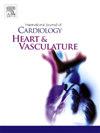Progress in the application of cardiac magnetic resonance to predict recurrence of atrial fibrillation after catheter ablation: A systematic review and meta-analysis
IF 2.5
Q2 CARDIAC & CARDIOVASCULAR SYSTEMS
引用次数: 0
Abstract
Background
This systematic review and meta-analysis aimed to assess changes in left atrial structure and function at baseline and after catheter ablation and their association with atrial fibrillation recurrence using cardiac magnetic resonance imaging (MRI).
Methods
As of June 2024, a total of 3086 articles have been obtained through searching PubMed, Embase, and Cochrane databases. Standard mean differences and 95% confidence intervals were used to examine structural and functional changes of left atrium after catheter ablation and their relationship with recurrence of atrial fibrillation.
Results
A total of 13 prospective cohort studies were included in the analysis. Decreased left atrial emptying capacity is seen in the short term after catheter ablation, and structural changes in the left atrium are seen in the long term (EFActive: SMD, 1.23, 95 % CI, 1.10–2.36, p < 0.05; EFTotal: SMD, 0.83, 95 % CI, 0.02–1.64, p < 0.05; MinLAV: SMD, 0.30, 95 % CI, 0.01–0.59, p < 0.05). Decrease in left atrial volume after catheter ablationis positively associated with the risk of recurrence of atrial fibrillation. (MaxLAV: SMD, 1.27, 95 % CI, 0.05, 2.49, p < 0.05; MaxLAVi: SMD, 0.48, 95 % CI, 0.05,0.9, p < 0.05;MinLAVi: SMD, 0.78, 95 % CI, 0.39,1.16, p < 0.05). The larger the left atrial volume and the lower the emptying and strain function, the greater the likelihood of recurrence of atrial fibrillation following catheter ablation, (MaxLAV: SMD, 0.38, 95 % CI, 0.18,0.59, p < 0.05;MinLAV: SMD, 0.83,95 % CI, 0.41,1.24, p < 0.05; MaxLAVi: SMD, 0.35, 95 % CI, 0.21,0.50, p < 0.05;MinLAVi: SMD, 0.62, 95 % CI, 0.47,0.78, p < 0.05; EFPassive: SMD, −0.57, 95 % CI, −0.78, −0.37, p < 0.05; EFActive: SMD, −0.62, 95 % CI, −1.08, −0.15, P < 0.05; EFTotal: SMD, −0.70, 95 % CI, −0.97, −0.44, P < 0.05; ℇCT: SMD, −0.61, 95 % CI, −0.90, −0.32, p < 0.05; PLAS: SMD, −1.22, 95 % CI, −1.87, −0.57, p < 0.05; ℇR: SMD, −0.50, 95 % CI, −0.79, −0.21, p < 0.05; PLAS: SMD, −1.22, 95 % CI, −1.87, −0.57, p < 0.05).
Conclusion
Short-term left atrial functional impairment can be observed after catheter ablation, while long-term reduction in left atrial volume can be seen. Changes in left atrial volume are likely to lead to the recurrence of atrial fibrillation, while alterations in left atrial function help maintain sinus rhythm. Larger left atrial volume and lower emptying and strain function at baseline assessment by cardiac magnetic resonance are more likely to lead to recurrence of atrial fibrillation after catheter ablation, which may be useful to identify those for whom catheter ablation has reduced success or for whom more aggressive ablation or medications may be useful.
求助全文
约1分钟内获得全文
求助全文
来源期刊

IJC Heart and Vasculature
Medicine-Cardiology and Cardiovascular Medicine
CiteScore
4.90
自引率
10.30%
发文量
216
审稿时长
56 days
期刊介绍:
IJC Heart & Vasculature is an online-only, open-access journal dedicated to publishing original articles and reviews (also Editorials and Letters to the Editor) which report on structural and functional cardiovascular pathology, with an emphasis on imaging and disease pathophysiology. Articles must be authentic, educational, clinically relevant, and original in their content and scientific approach. IJC Heart & Vasculature requires the highest standards of scientific integrity in order to promote reliable, reproducible and verifiable research findings. All authors are advised to consult the Principles of Ethical Publishing in the International Journal of Cardiology before submitting a manuscript. Submission of a manuscript to this journal gives the publisher the right to publish that paper if it is accepted. Manuscripts may be edited to improve clarity and expression.
 求助内容:
求助内容: 应助结果提醒方式:
应助结果提醒方式:


